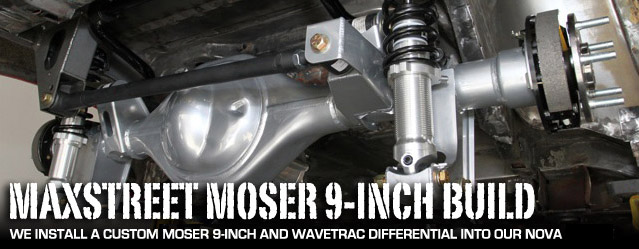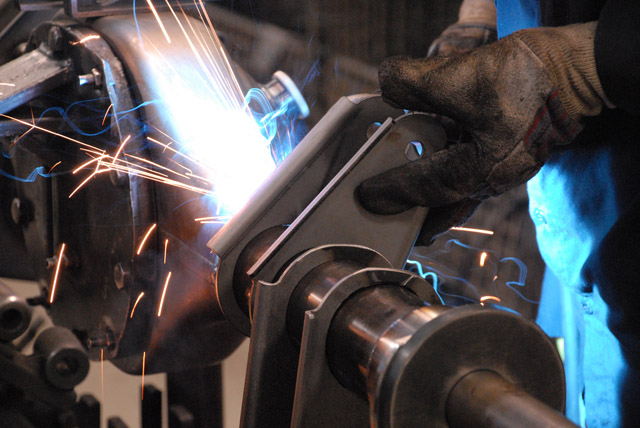You are at the dragstrip getting ready for a run. The revs come up on the chip, lights go green, the car moves about six inches while the motor pegs the rev limiter. A few minutes later, there is a jack under the rear end and four guys pushing it back from the front end. You sir, have just experienced a drivetrain failure. Though this is a relatively tame form of drivetrain failure; snapping axles mid-track never has a happy ending.
You can have all the power in the world, but if you cannot transmit that power to the rear tires properly, it doesn’t do you any good. This includes not only a good differential, but also bullet proof housing and a strong set of axles to support the package. When it came to putting a rear end into our Project MaxStreet Chevy II, we turned to Moser Engineering for that reliability, including their new Wavetrac differential.
Our 1966 Chevy II is receiving a low compression, Edelbrock/Musi 555ci big block Chevy with an F2 ProCharger. With 850 horsepower to the rear tires on low boost, we needed a rear end that could handle brutal power. But this isn’t a drag strip only Nova, it is a designed for all facets of asphalt motorsports, including a lot of street driving. This is where the new Wavetrac differential is going to help us, by supplying the power evenly to the rear tires regardless if it’s on the dragstrip or road course. Additionally, Moser’s ability to install our custom Detroit Speed four-link brackets during manufacturing made our job even easier.
Ford 9-inch Rear End – Found More In Chevys
What most don’t know is that the Ford 9-inch was first introduced in 1957. Many features like the drop-out center section design made it easy to service. Though the first variants were not as strong as its successors; the originals featured tubes welded to the center section with no supports. As the years progressed, triangulated housings and large-tube axle bearing ends were some of the benefits added to the housings.
As any product becomes popular, an aftermarket demand is born from it. Reinforced housings, gear ratios, a wide range of axle spline offerings and differentials made it easy for people to mix and match to their heart’s content.

The Moser 9-inch came with our Detroit Speed brackets welded on and powder coated. We simply had to install the center section, axles, and parking brake assembly
Building our Moser 9-inch for Project MaxStreet
Project MaxStreet is a 1966 Chevy II that is acquiring the modified 555 Edelbrock/Musi crate engine that was in Project Grandma. Now it is being fitted with low compression JE pistons, an F2 ProCharger, and a FAST XFI fuel injection system. We look to make around 850 horsepower to the rear tires while maintaining total street reliability. That means we needed a rear end that can perform perfectly on the street and drag strip. That means there is medley of situations that we need this Chevy II to perform in. It isn’t going to be as easy as throwing a spool in the housing and calling it a day. We needed a functional differential and a strong supporting package, but nothing off the wall.
When it came to designing the rear end that is going into MaxStreet, we turned to the “Build to Order” section of Moser’s website. We went with their 9-inch stamped housing that is constructed of seamless steel tubing. The seamless steel construction retains rigidity throughout the rear end by not having welded sections, or a flat piece of metal that has been rolled into a circle and welded.
The Ability to Install Any Custom Rear End Brackets With Moser
Part of the construction process is adding the proper mounts to the rear end. Since we had our Detroit Speed QuadraLink recently installed, we opted to send the rear end brackets to Moser so they could weld them on while building the housing. “We work with a lot of major chassis parts suppliers, like Detroit Speed, so if a customer wants to send their brackets, we can weld them to the housing without a problem,” said Jeff Anderson of Moser. “We do stock all popular OEM-type brackets. Those brackets are thicker and feature reinforcements that you won’t find on a direct OEM piece.”

The first course of action is to install the studs into the housing and put the gasket in place. After this, the center section drops in place.
Detroit Speed includes a diagram with the kit that tells the angle and spacing of the brackets on the rear end, all we had to do was fax the paper to Moser. Additionally, we welded in a pair of Detroit Speed’s Deep Tub wheel tubs that gave us an additional 2.5-inches of clearance for larger tires. With the tubs done, we fitted the 17×11” Billet Specialties Street Lites that are wrapped in 315/35/17 Mickey Thompson drag radials into the tubs. Without the rear end in it, we measured from the pad face of the rim on both sides and gave Moser a measurement of 52-inches.
Axle and Center Section…Selection
Moser recommended their custom alloy 35-spline axles with a standard Chevy 5 x 4.75” bolt pattern. This is the largest spline count you can get from Moser without going to a spool. A larger spline count allows for a larger root diameter, the same reason that fine thread bolts are stronger than the same size coarse thread bolt when placed in tension. Fine splines and high strength threads are usually rolled in, a forging operation that compresses the metal, making the surface dense. Cut splines break up the grain patterns in the metal weakening the area rather than strengthening it.
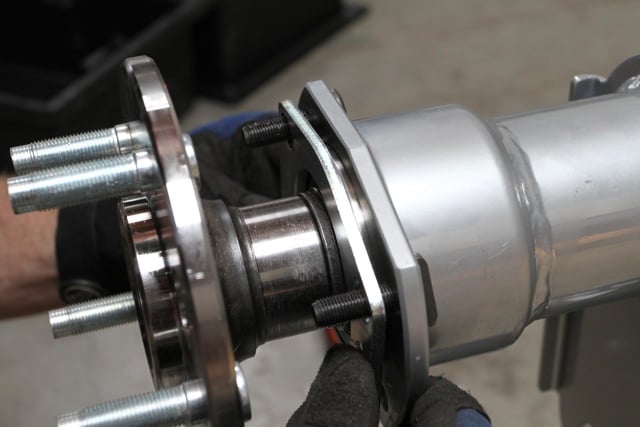
The axles come with the bearings already pressed on. The bearing sits into the housing end and is held in place by a retaining plate. If you have the parking brake option, the axle must be slid through the brake assembly and then installed into the housing end.
Our center section came fully assembled with a bulletproof nodular iron case, Wavetrac differential, yoke, as well as the ring and pinion. The nodular iron case is a heat-treated forging that is more cost effective (though a bit heavier) than their aluminum case offerings. The build to order rear ends also come complete with all bearings, hardware, and gaskets – with mild assembly required. We even went with the silver powder coat option for a superb finish.
Our Ford 9-inch Specs:
• 35-spline axles with a 5 x 4.75-inch spacing
• 52” long (with brakes) stamped steel housing
• Nodular iron center section, fully assembled
• Wavetrac differential
• Fill and drain plugs
• Custom welded 4-link brackets from Detroit Speed
• Sealed ball bearings
• Integrated parking brake option
Moser’s new Wavetrac Differential is Designed with Handling in Mind
One of the known shortcomings of a typical torque biasing differential is its loss of drive under zero or near-zero torque conditions. The Wavetrac is the latest and greatest in differentials from Moser that is designed to help you over come those “one wheel peel” problems. “The big advantage of the Wavetrac is how well it performs in light to partial throttle conditions,” explained Anderson. “Say you have a truck that has one wheel off the ground, the Wavetrac will help you get out of that situation safely without having to mash the throttle. You can also customize the Wavetrac to suit your driving or racing needs.”
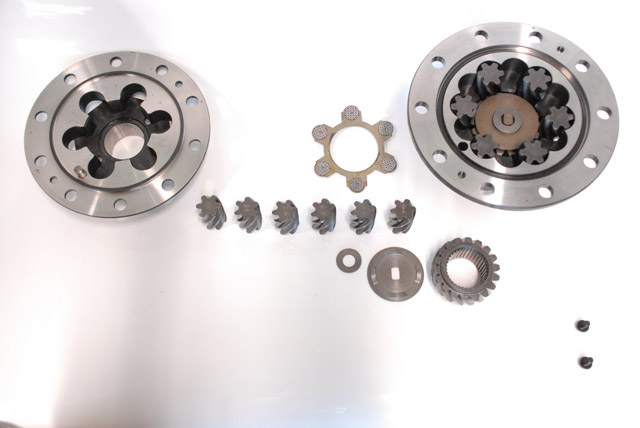
The Wavetrac differential is easy to disassemble and repair, while using minimal parts inside the differential. The Wavetrac uses converging/diverging wave profiles that are placed on one side gear and its mating preload hub. As the two side gears rotate relative to each other, each wave surface climbs the other, causing them to move apart.
The Wavetrac uses converging/diverging wave profiles that are placed on one side gear and its mating preload hub. As the two side gears rotate relative to each other, each wave surface climbs the other, causing them to move apart. This imparts an increased normal force through the side gears, increasing the bias ratio as a function of load. This increase occurs automatically only when conditions find it necessary, and it reverts back to its nominal bias ratio quickly and seamlessly, maintaining optimal driveability and performance at all times. It’s like having two differentials in one: you get the benefit of a higher bias ratio when needed without detriment to the car’s handling.
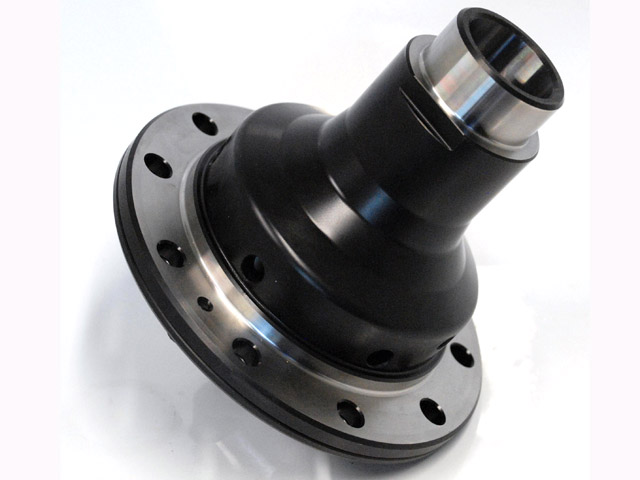
The Wavetrac differential is currently offered in GM 12-bolt and Ford 9-inch applications with a Ford 8.8-inch application in the works.
Assembling the Moser 9-inch Rear End
Installation was simple and straightforward. First we installed the studs that hold the center section into the housing. After that, we moved to pressing the bearings and seals into the axle housing. The nodular center section installs directly onto the studs with the supplied gasket.
Since we planned to drive the Chevy II on the street, we opted for Moser’s parking brake assembly, which must be slid over the end of the axles before installing the axles. Once the axles are installed into the housing, the retaining plates then secure the axle and parking brake assembly to the housing.

Assembly is very easy with the installation of the center section and axles being the only real task.
With the parking brake assembly finished, we began installing the Moser 9-inch onto the Detroit Speed four-link. The brackets we supplied to Moser lined up perfectly and it was as simple as installing the four-links, panhard, and shocks.
Building a rear end that has the ability to handle all the power you plan to throw at it is paramount in any vehicle build. Moser made the process easy, as we were able to send over our custom housing width to accommodate our mini tubs. Additionally, Moser was able to install our Detroit Speed QuadraLink brackets during the manufacturing process, which was a big help. Lastly, there is no doubt the Wavetrac’s converging/diverging wave profile technology will keep the traction to our rear wheels, regardless if we are at the dragstrip or road course.



